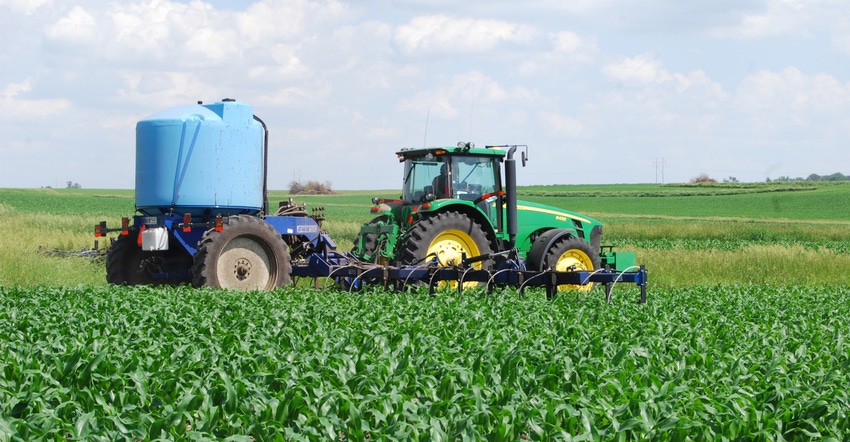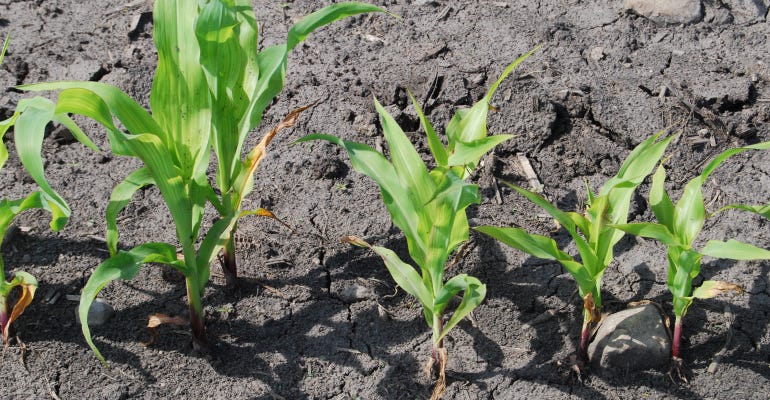June 13, 2019

With rain delayed and late corn planting this spring, nitrogen fertilizer hasn’t been applied yet on many fields. Whether you planted early or late, planting windows have been short and rushed. In many cases, this meant going ahead and planting and worrying about getting nitrogen applied later.
Also, in some areas of Iowa, this spring’s wetter-than-normal conditions are raising questions about the need for supplemental N applications. Some nitrogen was applied earlier. But with all the rain that followed, farmers now wonder whether they need to make a sidedress application, so corn doesn’t run short of this vital nutrient and limit yield.
What are the options for sidedressing N? John Sawyer, Iowa State University Extension soil fertility and nutrient management specialist, provides the following observations and recommendations.
Typical sidedress timing
If you decided to plant corn and then apply N sidedress, check to be sure the fertilizer products and application equipment being considered will be available. Sawyer lists the following sidedress options in order — ranging from those generally most preferable to those least preferable. However, product and equipment availability, and personal preference often constrain the fertilizer and application choice:
inject anhydrous ammonia, urea-ammonium nitrate (UAN) solution, or urea
broadcast dry ammonium nitrate or ammonium sulfate
surface-band UAN
broadcast urea treated with a urease inhibitor
broadcast urea
broadcast UAN (depends on plant size, see guidelines in this article)
Sidedress injection can begin immediately after planting if rows are visible or GPS equipment is used, Sawyer says. Be careful so soil moved during injection doesn’t cover seeded rows or small corn plants. It’s easiest to inject N in the row middle, and generally, there is no season-long advantage to place a nitrogen band close to the row, he notes. Corn roots will reach the row middle at early growth stages.
In cases where no N was applied preplant, no starter N applied, or preplant N was injected deep into the soil, a dribble application close to the corn row may help with early N availability and early growth.
“We may see streaking in fields with preplant anhydrous ammonia application, due to wet soils restricting early corn growth and low soil nitrate this spring, especially in corn following corn,” he says. Responding to another question he’s getting from farmers, Sawyer says sidedress N, either injected or dribbled, can also be applied between every other row.
Broadcast N over top of crop?
Broadcasting dry urea, ammonium sulfate or ammonium nitrate across growing corn might cause some leaf spotting or edge browning where fertilizer granules fall into the corn whorl. The chances of this happening increase with larger corn and high application rates.
“As long as the fertilizer distribution is good and not concentrated over plants, leaf damage should only be cosmetic,” Sawyer says. “Ammonium nitrate and ammonium sulfate will cause more leaf tissue damage than urea; however, supply is typically limited for those fertilizer products.”
Since UAN solution is half urea and half ammonium nitrate, concern over loss of volatile ammonia is less than with dry urea. Surface-banding UAN will reduce loss potential, he notes. Adding a urease inhibitor with surface-applied and nonincorporated urea and UAN will help reduce volatile loss (product labels often state up to 10 days, with loss increasing over time). The rate of N applied — the amount of potential N loss — has to be large enough to offset the urease inhibitor cost.
Conditions increasing the chance of volatile loss include:
no precipitation for many days after application
high amount of surface crop residue
warm temperatures
high surface soil pH
moist to drying soils
low soil cation exchange capacity
Precipitation within two to three days of application (about 0.25 to 0.50 inch) will stop volatile loss as urea is moved into the soil. Also, rain is needed to move surface-applied N into the crop root zone.
Potential for leaf burn
Broadcast application of UAN solution across growing corn has potential to cause leaf burn and reduced early growth. Research in Minnesota indicated that when corn plants were at V3 growth stage (three leaf collars visible), phytotoxic effects were worse at rates greater than 60 pounds N per acre (rates applied were zero, 60, 90 and 120 pounds of N per acre). However, damage was not permanent and did not adversely affect stand or yield.

NEEDS NITROGEN: Yellow corn plants are showing up in field areas this spring where wet soils restrict early corn growth and soils have low nitrate levels.

When plants were larger than the V3 stage, plant damage was worse, and some yield depression occurred with the rate of 120 pounds per acre.
Broadcast UAN applications beyond the V7 growth stage are not recommended, Sawyer says. Keep in mind the risk of corn injury increases during hot, dry conditions.
Many preemergence herbicides are applied using UAN as the carrier to minimize trips across fields. However, this strategy is only recommended before crop emergence. Most herbicides prohibit application in N solutions after corn has emerged. Check herbicide labels closely.
Mid- to late vegetative stage
If corn becomes too tall for normal sidedress equipment, it’s possible to use high-clearance equipment to apply N. The N sources typically will be a UAN solution, with equipment available to either dribble the solution onto the soil surface with drop or drag tubes. Or shallow-injection can be used with coulter-shank bars (coulter-disk injected) and dry urea, which can be broadcast across the top of corn. Leaf tissue symptoms from broadcasted dry urea can be more than with smaller corn, especially with full N application rates.
Research in Iowa has shown corn can respond to a nitrogen application during the mid- to late vegetative growth stage when the N supply is deficient, but there can be loss in yield potential, Sawyer explains. Reduced yield occurs more frequently when soils are dry at and after application (applied N not getting into the root zone) and with severe N stress. Best responses occur with sufficient rainfall shortly after application to move N into the active root zone.
If late N application is needed, it should be applied as quickly as possible, and not later than approximately the tassel stage.
Plant reference strips
Having some non-N-limiting reference strips (about 25% more than a normal N application rate) or small areas are helpful for comparisons, Sawyer says. These areas can be used to visually (or with sensing tools) determine if corn would respond to additional N, as a check to see if earlier N applications are not sufficient, and to determine that a crop color or growth issue is due to N deficiency and not some other stress.
These reference areas should be planned, and N applied early in the season if possible. Or use small areas with N applied now to check the visual response of corn plants, or refer to field areas that are known to be non-N deficient.
“The most important thing is to get N applied to corn,” Sawyer says. “While all product, method [and] timing options may not be ideal, not getting N applied is a much greater concern.”
Across the Corn Nitrogen Rate Calculator database in Iowa, the corn yield increase from N applied (yield at optimum N minus yield with no N) averages 100 bushels per acre in continuous corn and 70 bushels per acre in corn following soybeans.
Fine-tuning applications certainly helps ensure best yields possible for the year, but sometimes the risk of not getting N applied should also be considered. This year in mid-June, there is still a wide window for getting successful sidedress N applications completed for the 2019 corn crop.
About the Author(s)
You May Also Like






